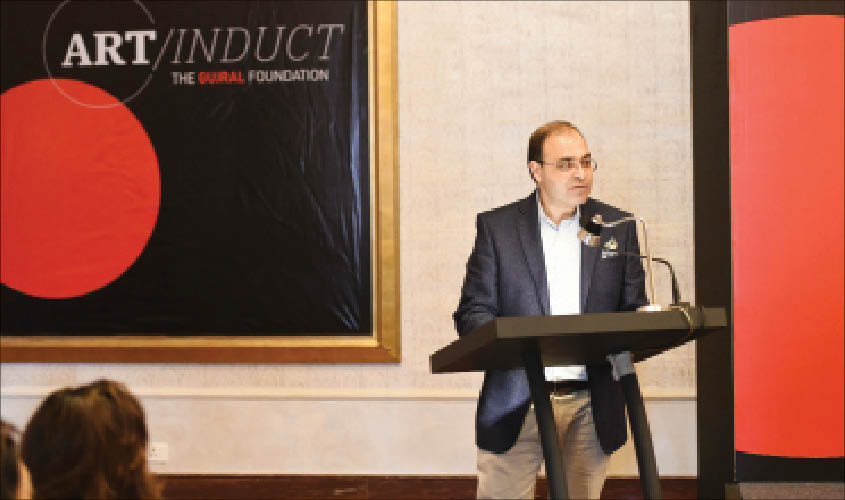Young FICCI Ladies Organisation and the Gujral Foundation co-organised a seminar on India’s contemporary art scene earlier this week in Delhi. The event was attended by art historians, collectors and leading auctioneers, writes Bhumika Popli.
A workshop on the diverse facets of the art industry, entitled Art Induct, was conducted at Delhi’s Bikaner house on 21 November. The event, organised by Young FICCI Ladies Organisation(YFLO) and the Gujral Foundation, brought together art historians, practitioners and market experts, all of whom attempted to offer their reading of the contemporary art scenario in India.
“In YFLO, we have younger members and all of us are investors, potential patrons and new collectors,” said Atashi Singhania, YFLO chairperson, Delhi. “Art is very easily accessible which not everyone knows. We often set aside a small amount of money which we don’t mind spending on art. But to know exactly where to spend and how to spend, there needs to be certain guidance. The idea of this event is art education, where the discussions feature every aspect of the art world. We asked Feroze Gujral, artistic director, the Gujral Foundation, to curate this programme for us.”

According to Feroze Gujral, Art Induct is part of the Gujral Foundation’s Knowledge Programme, which organises seminars on subjects such as Indian art history, art appreciation and collection. This particular workshop was meant for members of the YFLO, including some 100 young business leaders, collectors and art enthusiasts.
The panel of speakers included Peter Nagy, director, Nature Morte Gallery; art historian Gayatri Sinha; and art collector Nitin Bhayana among others.
Gayatri Sinha introduced the audience to Critical Collective, a website which serves as a knowledge bank on multiple topics related to Indian art. The online repository includes material on painting, sculpture, photography, decorative arts and cinema. The website aims at popularising new ways of interpreting Indian visual arts.

The Delhi workshop turned interactive when the workshop attendees participated in a mock auction conducted by Mallika Advani, an auctioneer at Mumbai’s Pundole’s auction house. Here, a small-sized resin sculpture made by Ravinder Reddy, entitled Torso, went under the hammer. Advani’s session, “Demystifying the Art World”, gave us valuable insights into the world of art auctions. She said, “An auction house is a secondary market for the artists and it is advisable that when an artist is established then he or she should reach out to this public platform.”
She decoded the terminology used at auctions for the benefit of the general public. “‘Property’ is used for the artwork and ‘condition report’ addresses the quality of the artwork,” said Advani.
According to her, it is important that the buyer reads the catalogue before investing in an artwork, as the catalogue gives a clear idea about the quality of the work up for auction.
It is not easy to invest in art. Most of the times, buyers are left with many questions having to do with the kind of art they want to invest in. Nitin Bhayana, who has been collecting art since 30 years, shared important lessons on the business of collecting. Mentors played a huge role in helping him build his collection.
About his experience of his initial years when he started out as a collector, he said, “It was fortunate to have really good mentors as this laid the foundation for me. My first mentor was acclaimed artist Manjit Bawa. I met him when I was 15. We became good friends and I don’t know what led to this exceptional friendship. I began investing as I had this curiosity. I used to think about art and about specific artworks. I travelled, visited studios and had many interesting discussions with Bawa, which sort of laid the foundation for me as a collector. And later on, I had set my own pace.”
Bhayana also shared some of key rules for building a collection as suggested by another mentor of his, Jagdish Mittal. Mittal is a veteran who has been collecting Indian classical art since the late 1940s. He, along with his wife Kamla, has built a museum in Hyderabad. The museum is called Jagdish and Kamla Mittal Museum of Indian Art.
“Jagdish Mittal told me to approach the business of collecting with humility. If you don’t understand something, read and ask multiple questions about the particular artwork you are planning to buy and once you commit to buying an artwork, it is imperative to keep your commitment on the payment. Also, keep the communication channels open. If you don’t like a work of art, instead of keeping the seller waiting, communicate.He [Mittal] also told me not to negotiate and at the same time respect the consultant, because a consultant is the one who helps you build your collection,” said Bhayana.
Another speaker at the event, the artist and educator Sharmila Samant, introduced the audience to the organisation, Art1st, she is an advisor to. The organisation prepares future art educators and helps children and adults to utilise their creative sensibilities to the optimum level. “The syllabus at Art1st in not something which will make you an artist, but it will surely encourage you to think outside the box, ”
said Samant.

